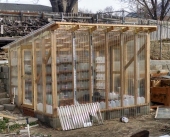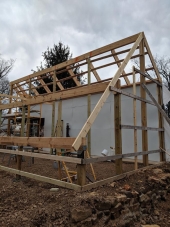





 2
2




New location. Zone 6b, acid soil, 30+ inches of water per year.
https://growingmodernlandraces.thinkific.com/?ref=b1de16
Growingmodernlandraces.com affiliate
 1
1





I make a Maple Syrup instructional movie! Check it out HERE
SKIP books, get 'em while they're hot!!! Skills to Inherit Property
See me in a movie building a massive wood staircase:Low Tech Lab Movie




Mike Jay wrote:
What is the roofing material? Does snow sit on it all winter?
Can you pile snow around the base on all four sides to insulate the ground a bit?
If the block wall behind it has open cores (square holes), they may be allowing cold air to travel within the wall, cooling it down and reducing its helpfulness.
Could you insulate the North wall? You probably don't get any sunlight though it so it is a wall that gives no solar gain and a fair amount of heat loss.
New location. Zone 6b, acid soil, 30+ inches of water per year.
https://growingmodernlandraces.thinkific.com/?ref=b1de16
Growingmodernlandraces.com affiliate
 1
1




I make a Maple Syrup instructional movie! Check it out HERE
SKIP books, get 'em while they're hot!!! Skills to Inherit Property
See me in a movie building a massive wood staircase:Low Tech Lab Movie




Mike Jay wrote:First off, you're already doing great. A few thoughts for ways to boost your temperatures this winter would be:
Try to hold the snow on the roof during the coldest part of winter when the sun is low. Unless it blocks a bunch of light, the insulation would help hold in a ton of your heat. If it would block too much sun, maybe still try to insulate the North half. Of course you could try removable insulation that you put on in winter and remove in summer instead of relying on a layer of snow.
Digging down the 6" around the perimeter and adding some underground insulation would help keep the cold ground outside the greenhouse from transmitting under and into your greenhouse. I'm putting styrofoam in a "Swedish skirt" arrangement so it goes down a foot and then horizontally out 3 feet. I have a 4' frost depth in my area so that will keep it from encroaching under my greenhouse.
I like the compost idea and will be trying it myself. I think the recommended minimum size for it to generate good heat is 3' by 3' by 3'. I'm guessing a smaller volume would still work but need more tending and quicker addition of new material. One key is for the compost to be in a lump/ball/cube/pile. If the same volume is spread around the floor 4" deep, while it may be the same amount of compost, it won't be able to feed off its own heat to get composting.
New location. Zone 6b, acid soil, 30+ inches of water per year.
https://growingmodernlandraces.thinkific.com/?ref=b1de16
Growingmodernlandraces.com affiliate
 1
1




I make a Maple Syrup instructional movie! Check it out HERE
SKIP books, get 'em while they're hot!!! Skills to Inherit Property
See me in a movie building a massive wood staircase:Low Tech Lab Movie




New location. Zone 6b, acid soil, 30+ inches of water per year.
https://growingmodernlandraces.thinkific.com/?ref=b1de16
Growingmodernlandraces.com affiliate
 1
1




I make a Maple Syrup instructional movie! Check it out HERE
SKIP books, get 'em while they're hot!!! Skills to Inherit Property
See me in a movie building a massive wood staircase:Low Tech Lab Movie




New location. Zone 6b, acid soil, 30+ inches of water per year.
https://growingmodernlandraces.thinkific.com/?ref=b1de16
Growingmodernlandraces.com affiliate
 1
1




 1
1




I make a Maple Syrup instructional movie! Check it out HERE
SKIP books, get 'em while they're hot!!! Skills to Inherit Property
See me in a movie building a massive wood staircase:Low Tech Lab Movie




Jerome Lee wrote:Anyone done the math on the effectiveness of water jugs for regulating temperature? (Or has some empirical data to share?)
New location. Zone 6b, acid soil, 30+ inches of water per year.
https://growingmodernlandraces.thinkific.com/?ref=b1de16
Growingmodernlandraces.com affiliate
 1
1








Mike Jay wrote:Here's a thread on the topic of thermal mass: Thermal mass for hoop house
I don't have any data to share but I've read a fair bit about it. From what I recall, drums collect and distribute heat over the course of days, 5 gallon buckets do so over the course of a day or so and gallon jugs are over the course of hours. So the time span that they need to be able to help your greenhouse partially dictates their size. Painting them black or a dark color helps them absorb heat, putting them in the sun also helps.
New location. Zone 6b, acid soil, 30+ inches of water per year.
https://growingmodernlandraces.thinkific.com/?ref=b1de16
Growingmodernlandraces.com affiliate




Gardens in my mind never need water
Castles in the air never have a wet basement
Well made buildings are fractal -- equally intelligent design at every level of detail.
Bright sparks remind others that they too can dance
What I am looking for is looking for me too!





Bless your Family,
Mike
 2
2




Pearl Sutton wrote:I'm a dumpster diver/recycler type. The bottles you have water in are going to sun damage fast in your climate. If you don't want the floor wet by them when they leak, make arrangements for where the water will go. I really wish they made those out of better plastic for those of us who reuse them, they don't, so mitigate the damage that they might cause. That thread of mine above had a suggestion to put the small thermal masses right by the plants, that may be a useful thought for you too. I'm using Folger's coffee cans for my smaller thermal masses, they are tougher plastic and stack well.
Lovely work! Looks beautiful!! Keep us posted on how it does this winter :)
New location. Zone 6b, acid soil, 30+ inches of water per year.
https://growingmodernlandraces.thinkific.com/?ref=b1de16
Growingmodernlandraces.com affiliate





|
Frankly, my dear, I don't give a damn. But if you read my tiny ad, I might change my mind.
Freaky Cheap Heat - 2 hour movie - HD streaming
https://permies.com/wiki/238453/Freaky-Cheap-Heat-hour-movie
|





